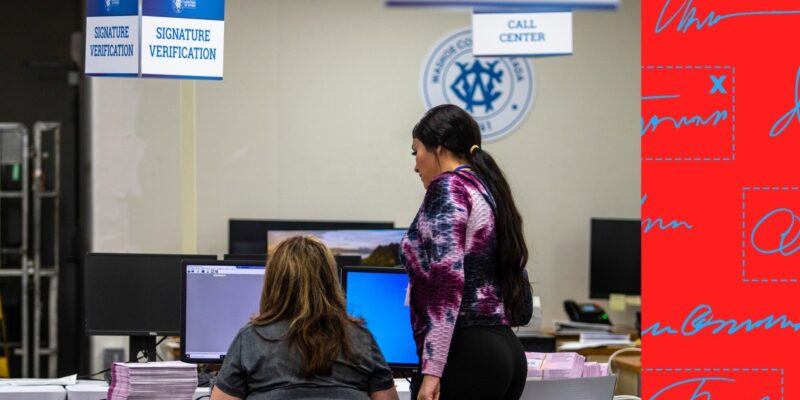
Nevada’s secretary of state, the New York Times’ Danny Hakim reports, is concerned about the large numbers of absentee ballots getting rejected in the state’s most populous counties because of signature mismatches—potentially enough ballots to change election results. From the Times:
More than 11,300 ballots were reported by the state Monday night as still needing signature curing in Clark County, home of Las Vegas, and more than 1,800 in Washoe County. In particularly close elections, a large number of ballots that need curing could determine the outcome.
States that make such comparisons typically match the voter’s signature on the absentee ballot envelope against signatures in the registrar’s voter database and DMV records. If a mismatch is declared, voters are given the opportunity to “cure” a rejected ballot—in Nevada this year, they have through November 12.
The numbers above were much higher than the ones reported in 2020 and 2022, and they are expected to grow as more ballots arrive and are processed, Hakim wrote. “It’s mostly the fact that young people don’t have signatures these days,” Secretary of State Francisco Aguilar told the Times. “And when they did register to vote through the automatic voter registration process, they signed a digital pad at DMV, and that became their license signature.”
This is a problem his office might have seen coming, and it’s just one reason that having minimally trained people matching ballot signatures is not a great practice. Or so people who do it for a living told me when I was reporting on the subject during a past election.
There’s a lot of natural variation in people’s script related to health issues, aging, injuries, changes in mental state, and the circumstances in which a signature is created—that DMV touch pad yields a very different signature than a ballpoint pen at a desk will, for example.
“A person could write their signature 100 different times and none of those will be exactly alike.”
Sample size is also an issue. “You have to have a series of signatures,” Patricia Fisher, a professional documents examiner from Northern California, told me. “They need to be closer in time, and on similar types of documents, because one signature is not going to represent the full range of variations in someone’s handwriting.”
Fisher, who at the time had spent more than four decades verifying disputed signatures, said her No. 1 rule was as follows: You never compare just two signatures to determine a mismatch. And you certainly don’t call a mismatch by comparing a recent signature with one collected years earlier—as might be the case with older voters who originally registered to vote—or drive—some time ago.
Six signatures is about the minimum for a solid comparison, Fisher told me. A trained examiner looks for “the commonalities, the permanent characteristics, the fleeting characteristics, the other characteristics like the fluency, the speed, the rhythm. There are dozens of variables,” she said.
I spoke, too, with Mark Songer, a former forensic documents examiner for the FBI. “To do any kind of meaningful examination, I like to get anywhere from 6 to 10 representative samples that are pretty contemporaneous with the signature itself,” he told me. “A person could write their signature 100 different times and none of those will be exactly alike, because we all have a range—the only way to establish that range is to have a sufficient number of samples.”
Signature disputes are becoming increasingly common as more people, starting during the pandemic, began voting absentee. And thanks to the ubiquity of touch-pad signatures and the fact that cursive is no longer taught in many schools, signatures have become ever less reliable as a quick verification of a person’s identity.
“If they use a driver’s license signature and you’re signing an electronic pad, that changes many of the characteristics, because it’s not natural,” Fisher told me. “So you’re comparing apples and oranges for such an important thing—to say, ‘No, your vote doesn’t count because your signature doesn’t look right.’”
For a lot of those Nevada voters, that may be the only thing on file: “We’re seeing high engagement and turnout amongst our youth,” Aguilar told CNN.
I reached out to Nevada officials to ask whether it was true, per a rumor on X, that elections workers were attempting to call those voters, as opposed to, say, texting them. Because, I have a couple of first-time voters in my own household, and those people do not pick up the phone—unless it’s dad, and sometimes not even then.
A Clark County elections spokesperson assured me that elections staffers do, in fact, text voters—and call and email and even send them notices in the mail, and then continue to do so right up to the deadline. Yet despite these efforts, she said, only about half of the rejected ballots got cured in previous elections. That could yet be significant, since Clark County still had 9,600 uncured ballots as of 4 p.m. PT. And Washoe County’s website listed 1,375 still in need of curing.
In any case, “the whole signature thing needs to be totally reevaluated,” Fisher told me. “There should not be all these untrained people—and you probably won’t get trained people there, because trained persons know you don’t compare one signature to another signature.”















